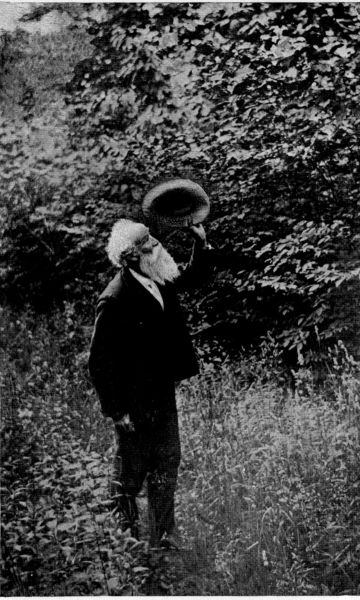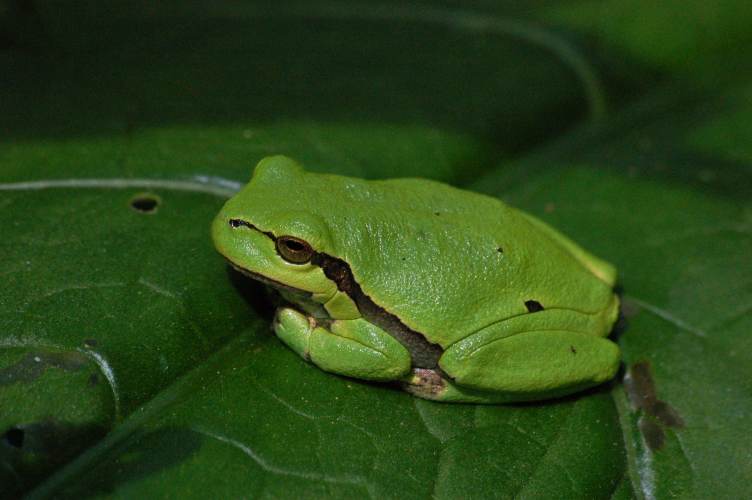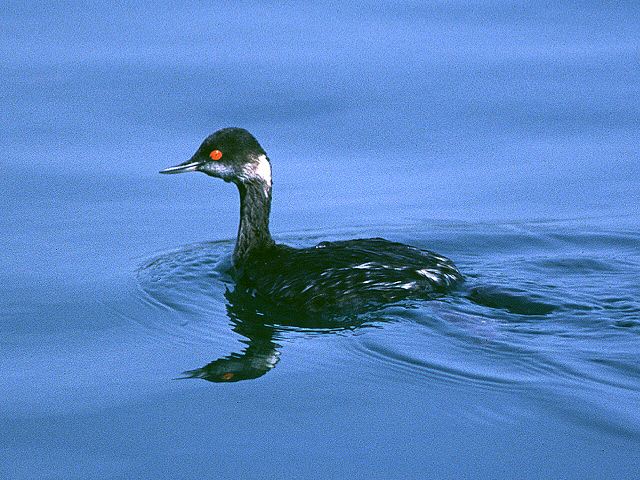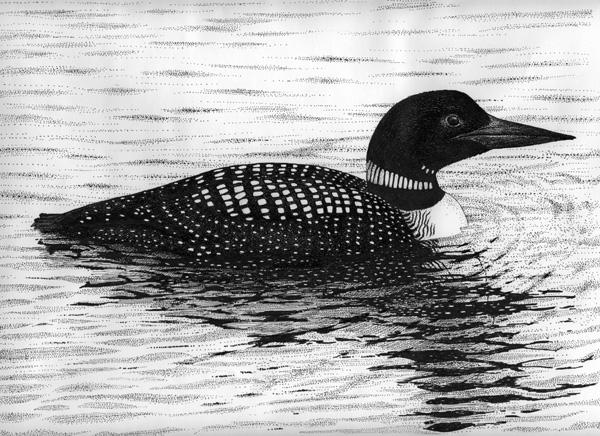Ways Of Nature
‘The Power To See Straight Is The Rarest of Gifts’
By John Burroughs
Naturalist and essayist John Burroughs (April 3, 1837-March 29, 1921) occupies a permanent place in American literature. Though he was a leading literary critic in his day, he was a pioneer in the new school of nature writing and the most popular writer of his period in the field he made his own. Burroughs' legacy of some twenty-five volumes, of which more than a million and a half copies were sold during his lifetime, has had a profound influence on our appreciation of nature. From Burroughs’s 1905 book Ways of Nature, this month’s Nature’s Temple features the author’s preface and Chapter XIII, ‘Reading the Book of Nature,’ on seeing what the natural world is really showing us rather than trying to understand it by humanizing it.
Preface
My reader will find this volume quite a departure in certain ways from the tone and spirit of my previous books, especially in regard to the subject of animal intelligence. Heretofore I have made the most of every gleam of intelligence of bird or four-footed beast that came under my observation, often, I fancy, making too much of it, and giving the wild creatures credit for more "sense" than they really possessed. The nature lover is always tempted to do this very thing; his tendency is to humanize the wild life about him, and to read his own traits and moods into whatever he looks upon. I have never consciously done this myself, at least to the extent of willfully misleading my reader. But some of our later nature writers have been guilty of this fault, and have so grossly exaggerated and misrepresented the every-day wild life of our fields and woods that their example has caused a strong reaction to take place in my own mind, and has led me to set about examining the whole subject of animal life and instinct in a way I have never done before.
In March, 1903, I contributed to The Atlantic Monthly a paper called "Real and Sham Natural History," which was as vigorous a protest as I could make against the growing tendency to humanize the lower animals. The paper was widely read and discussed, and bore fruit in many ways, much of it good and wholesome fruit, but a little of it bitter and acrid. For obvious reasons that paper is not included in this collection. But I have given all the essays that were the outcome of the currents of thought and inquiry that it set going in my mind, and I have given them nearly in the order in which they were written, so that the reader may see the growth of my own mind and opinions in relation to the subject. I confess I have not been fully able to persuade myself that the lower animals ever show anything more than a faint gleam of what we call thought and reflection—the power to evolve ideas from sense impressions—except feebly in the case of the dog and the apes, and possibly the elephant. Nearly all the animal behavior that the credulous public looks upon as the outcome of reason is simply the result of the adaptiveness and plasticity of instinct. The animal has impulses and impressions where we have ideas and concepts. Of our faculties I concede to them perception, sense memory, and association of memories, and little else. Without these it would be impossible for their lives to go on.
I am aware that there is much repetition in this volume, and that the names of several of the separate chapters differ much more than do the subjects discussed in them.
When I was a boy on the farm, we used to thrash our grain with the hand-flail. Our custom was to thrash a flooring of sheaves on one side, then turn the sheaves over and thrash them on the other, then unbind them and thrash the loosened straw again, and then finish by turning the whole over and thrashing it once more. I suspect my reader will feel that I have followed the same method in many of these papers. I have thrashed the same straw several times, but I have turned it each time, and I trust have been rewarded by a few additional grains of truth.
Let me hope that the result of the discussion or thrashing will not be to make the reader love the animals less, but rather to love the truth more.
June, 1905.
Reading The Book Of Nature
In studying Nature, the important thing is not so much what we see as how we interpret what we see. Do we get at the true meaning of the facts? Do we draw the right inference? The fossils in the rocks were long observed before men drew the right inference from them. So with a hundred other things in nature and life.
During May and a part of June of 1903, a drought of unusual severity prevailed throughout the land. The pools and marshes nearly all dried up. Late in June the rains came again and filled them up. Then an unusual thing happened: suddenly, for two or three days and nights, the marshes about me were again vocal with the many voices of the hyla, the "peepers" of early spring. That is the fact. Now, what is the interpretation? With me the peepers become silent in early May, and, I suppose, leave the marshes for their life in the woods. Did the drought destroy all their eggs and young, and did they know this and so come back to try again? How else shall one explain their second appearance in the marshes? But how did they know of the destruction, of their young, and how can we account for their concerted action? These are difficulties not easily overcome. A more rational explanation to me is this, namely, that the extreme dryness of the woods—nearly two months without rain—drove the little frogs to seek for moisture in their spring haunts, where in places a little water would be pretty certain to be found. Here they were holding out, probably hibernating again, as such creatures do in the tropics during the dry season, when the rains came, and here again they sent up their spring chorus of voices, and, for aught I know, once more deposited their eggs. This to me is much more like the ways of Nature with her creatures than is the theory of the frogs' voluntary return to the swamps and pools to start the season over again.
Hyla Arborea (tree frog): ‘…suddenly, for two or three days and nights, the marshes about me were again vocal with the many voices of the hyla, the ‘peepers’ of early spring. That is the fact. Now, what is the interpretation?’The birds at least show little or no wit when a new problem is presented to them. They have no power of initiative. Instinct runs in a groove, and cannot take a step outside of it. One May day we started a meadowlark from her nest. There were three just hatched young in the nest, and one egg lying on the ground about two inches from the nest. I suspected that this egg was infertile and that the bird had had the sense to throw it out, but on examination it was found to contain a nearly grown bird. The inference was, then, that the egg had been accidentally carried out of the nest some time when the sitting bird had taken a sudden flight, and that she did not have the sense to roll or carry it back to its place.
There is another view of the case which no doubt the sentimental "School of Nature Study" would eagerly adopt: A very severe drought reigned throughout the land; food was probably scarce, and was becoming scarcer; the bird foresaw her inability to care for four young ones, and so reduced the possible number by ejecting one of the eggs from the nest. This sounds pretty and plausible, and so credits the bird with the wisdom that the public is so fond of believing it possesses. Something like this wisdom often occurs among the hive bees in seasons of scarcity; they will destroy the unhatched queens. But birds have no such foresight, and make no such calculations. In cold, backward seasons, I think, birds lay fewer eggs than when the season is early and warm, but that is not a matter of calculation on their part; it is the result of outward conditions.
A great many observers and nature students at the present time are possessed of the notion that the birds and beasts instruct their young, train them and tutor them, much after the human manner. In the familiar sight of a pair of crows foraging with their young about a field in summer, one of our nature writers sees the old birds giving their young a lesson in flying. She says that the most important thing that the elders had to do was to teach the youngsters how to fly. This they did by circling about the pasture, giving a peculiar call while they were followed by their flock—all but one. This was a bobtailed crow, and he did not obey the word of command. His mother took note of his disobedience and proceeded to discipline him. He stood upon a big stone, and she came down upon him and knocked him off his perch. "He squawked and fluttered his wings to keep from falling, but the blow came so suddenly that he had not time to save himself, and he fell flat on the ground. In a minute he clambered back upon his stone, and I watched him closely. The next time the call came to fly he did not linger, but went with the rest, and so long as I could watch him he never disobeyed again." I should interpret this fact of the old and young crows flying about a field in summer quite differently. The young are fully fledged, and are already strong flyers, when this occurs. They do not leave the nest until they can fly well and need no tutoring. What the writer really saw was what any one may see on the farm in June and July: she saw the parent crows foraging with their young in a field The old birds flew about, followed by their brood, clamorous for the food which their parents found. The bobtailed bird, which had probably met with some accident, did not follow, and the mother returned to feed it; the young crow lifted its wings and flapped them, and in its eagerness probably fell off its perch; then when its parent flew away, it followed.
I think it highly probable that the sense or faculty by which animals find their way home over long stretches of country, and which keeps them from ever being lost as man so often is, is a faculty entirely unlike anything man now possesses. The same may be said of the faculty that guides the birds back a thousand miles or more to their old breeding-haunts. In caged or housed animals I fancy this faculty soon becomes blunted. President Roosevelt tells in his "Ranch Life" of a horse he owned that ran away two hundred miles across the plains, swimming rivers on the way to its old home. It is very certain, I think, that this homing feat is not accomplished by the aid of either sight or scent, for usually the returning animal seems to follow a comparatively straight line. It is, or seems to be, a consciousness of direction that is as unerring as the magnetic needle. Reason, calculation, and judgment err, but these primary instincts of the animal seem almost infallible.
A grebe (left) and a loon: The birds and the beasts often show much intelligence, or what looks like intelligence, but, as Hamerton says, ‘the moment we think of them as human, we are lost.’In Bronx Park in New York a grebe and a loon lived together in an enclosure in which was a large pool of water. The two birds became much attached to each other and were never long separated. One winter day on which the pool was frozen over, except a small opening in one end of it, the grebe dived under the ice and made its way to the far end of the pool, where it remained swimming about aimlessly for some moments. Presently the loon missed its companion, and with an apparent look of concern dived under the ice and joined it at the closed end of the pool. The grebe seemed to be in distress for want of air. Then the loon settled upon the bottom, and with lifted beak sprang up with much force against the ice, piercing it with its dagger-like bill, but not breaking it. Down to the bottom it went again, and again hurled itself up against the ice, this time shattering it and rising to the surface, where the grebe was quick to follow. Now it looked as if the loon had gone under the ice to rescue its friend from a dangerous situation, for had not the grebe soon found the air, it must have perished, and persons who witnessed the incident interpreted it in this way. It is in such cases that we are so apt to read our human motives and emotions into the acts of the lower animals. I do not suppose the loon realized the danger of its companion, nor went under the ice to rescue it. It followed the grebe because it wanted to be with it, or to share in any food that might be detaining it there, and then, finding no air-hole, it proceeded to make one, as it and its ancestors must often have done before. All our northern divers must be more or less acquainted with ice, and must know how to break it. The grebe itself could doubtless have broken the ice had it desired to. The birds and the beasts often show much intelligence, or what looks like intelligence, but, as Hamerton says, "the moment we think of them as human, we are lost."
A farmer had a yearling that sucked the cows. To prevent this, he put on the yearling a muzzle set full of sharpened nails. These of course pricked the cows, and they would not stand to be drained of their milk. The next day the farmer saw the yearling rubbing the nails against a rock in order, as he thought, to dull them so they would not prick the cows! How much easier to believe that the beast was simply trying to get rid of the awkward encumbrance upon its nose. What can a calf or a cow know about sharpened nails, and the use of a rock to dull them? This is a kind of outside knowledge—outside of their needs and experiences—that they could not possess.
An Arizona friend of mine lately told me this interesting incident about the gophers that infested his cabin when he was a miner. The gophers ate up his bread. He could not hide it from them or put it beyond their reach. Finally, he bethought him to stick his loaf on the end of a long iron poker that he had, and then stand up the poker in the middle of his floor. Still, when he came back to his cabin, he would find his loaf eaten full of holes. One day, having nothing to do, he concluded to watch and see how the gophers reached the bread, and this was what he saw: The animals climbed up the side of his log cabin, ran along one of the logs to a point opposite the bread, and then sprang out sidewise toward the loaf, which each one struck, but upon which only one seemed able to effect a lodgment. Then this one would cling to the loaf and act as a stop to his fellows when they tried a second time, his body affording them the barrier they required. My friend felt sure that this leader deliberately and consciously aided the others in securing a footing on the loaf. But I read the incident differently. This successful jumper aided his fellows without designing it. The exigencies of the situation compelled him to the course he pursued. Having effected a lodgment upon the impaled loaf, he would of course cling to it when the others jumped so as not to be dislodged, thereby, willy-nilly, helping them to secure a foothold. The cooperation was inevitable, and not the result of design.
The power to see straight is the rarest of gifts; to see no more and no less than is actually before you; to be able to detach yourself and see the thing as it actually is, uncolored or unmodified by your own sentiments or prepossessions. In short, to see with your reason as well as with your perceptions, that is to be an observer and to read the book of nature aright.
John Burroughs assisted and watched by workers, children, and others including Henry and Clara Ford, lays rocks for the rock garden at the Henry Ford Estate, Fair Lane, Dearborn, Michigan, 1916.***
The John Burroughs Natural Historical Society
The John Burroughs Natural History Society strives to foster the study and enjoyment of natural history and to encourage conservation of natural resources. The organization reaches out to the general public via field trips, lectures, and a newsletter called The Chirp. Field trips, offered several times each month, cover a wide variety of interests including bird watching, flower identification, geology, insects, and herptiles. Walks take place throughout the county and adjacent areas, from the Hudson River to the Catskill Mountains.
History
The Society was organized in 1950 by a group of scientists and educators to serve as a source of information about the flora, fauna, and natural history of Ulster County. The name of the great writer-naturalist was chosen for the organization because Burroughs lived most of his life in the county. In 1964, the Society was incorporated by the University of New York as a non-profit educational organization. During the years there has been an increase in membership and a widening scope of activities.Purpose and Activities
The Society strives to foster the study and enjoyment of natural history and to encourage conservation of natural resources. The organization reaches out to the general public via field trips, lectures, and a newsletter called The Chirp. Field trips, offered several times each month, cover a wide variety of interests including bird watching, flower identification, geology, insects, and herptiles. Walks take place throughout the county and adjacent areas, from the Hudson River to the Catskill Mountains.Meetings are held four times a year. They are conducted with a minimum of formality and a generous amount of fellowship. The meetings in September, November and March are followed by a talk (usually illustrated). The June meeting includes a picnic at the Burroughs Sanctuary.
Publications
The official newsletter of the Society is its bi-monthly publication, The Chirp. It contains, among other items, notes on members’, activities, articles on local natural history and larger environmental issues, book reviews, reports of completed field trips and notices of upcoming trips and meetings. The most significant publication of the Society is The Flora of Ulster County, New York, by Henry Dunbar and Mary Domville. It is an annotated list of more than 1900 species of plants thus far identified in Ulster County. This publication and a bird check list are available.Membership
Anyone interested in the purpose of the Society is eligible for membership. Present membership ranges from professional biologists to amateur observers, and includes a wide span of ages. To join the Society, send a check for the dues to the Treasurer. Dues are $15 per year for either an individual or a family.Also, visit the John Burroughs Association website for more information on the various literary awards, educational efforts, nature essays, events and notices. Using the collections of the American Museum of Natural History Library as a springboard, the purpose of this site is three-fold: to serve as an online resource for Burroughs scholars and students by bringing together biographical and critical information about John Burroughs; to provide information about the John Burroughs Association and its activities; and to highlight the collections of the American Museum of Natural History, which contains a permanent exhibit dedicated to Burroughs, and its Library, which is a repository of several collections of photographs and early film.
Founder/Publisher/Editor: David McGee
Contributing Editors: Billy Altman, Laura Fissinger, Christopher Hill, Derk Richardson
Logo Design: John Mendelsohn (www.johnmendelsohn.com)
Website Design: Kieran McGee (www.kieranmcgee.com)
Staff Photographers: Audrey Harrod (Louisville, KY; www.flickr.com/audreyharrod), Alicia Zappier (New York)
E-mail: thebluegrassspecial@gmail.com
Mailing Address: David McGee, 201 W. 85 St.—5B, New York, NY 10024







